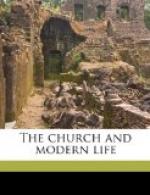“While,” says Dr. Lindsay, “the social tumults and popular uprisings against authority, which are a feature of the close of the Middle Ages, are usually and rightly enough called peasant insurrections, the name tends to obscure their real character. They were rather the revolts of the poor against the rich, of debtors against creditors, of men who had scantly legal rights or none at all, against those who had the protection of the existing laws; and they were joined by the poor of the towns as well as by the peasantry of the country districts. The peasants generally began the revolt and the townsmen followed, but this was not always the case. Sometimes the mob of the cities rose first and the peasants joined afterwards. In many cases, too, the poorer nobles were in secret or open sympathy with the insurrectionary movement. On more than one occasion they led the insurgents and fought at their head."[24]
The uprising against the church was due to the fact that the church, instead of being the friend of the poor, had become their social oppressor. Through all these social mutterings runs the outcry against the priests, and this was not because the priests were teaching a false theology, but because they were grinding the faces of the poor. Not only in Germany, but all over Europe this cry was heard. “The priests,” says an English reformer, “have their tenth part of all the corn, meadows, pasture, grain, wood, colts, lambs, geese, and chickens. Over and besides the tenth part of every servant’s wages, wool, milk, honey, wax, cheese, and butter; yea and they look so narrowly after these profits that the poor wife must be accountable to them for every tenth egg, or else she getteth not her rights at Easter, and shall be taken as a heretic.” “I see,” said a Spaniard, “that we can scarcely get anything from Christ’s ministers but for money; at baptism money, at bishoping money, at marriage money, for confession money,—no, not extreme unction without money! They will ring no bells without money, no burial in the church without money; so that it seemeth that Paradise is shut up from them that hath no money. The rich is buried in the church, the poor in the churchyard. The rich man may marry with his nearest kin, but the poor not so, albeit he be ready to die for love of her. The rich may eat flesh in Lent, but the poor may not, albeit fish perhaps be much dearer. The rich man may readily get large indulgences, but the poor none because he wanteth money to pay for them."[25]
This revolt against priestly oppression was by no means, however, an irreligious uprising. It was characterized by intense religious feeling, with which, as Dr. Lindsay says, “was blended some confused dream that the kingdom of God might be set up on earth, if only the priests were driven out of the land.” Among a populace so ignorant it was, of course, inevitable that the social revolt should take on fanatical forms. Wild zealots arose, drawing the multitude after them,




